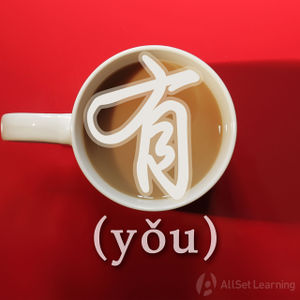Difference between revisions of "Expressing existence with "you""
(→Books) |
|||
| Line 40: | Line 40: | ||
[[Category:A1 grammar points]] | [[Category:A1 grammar points]] | ||
{{Used for|Expressing existence}} | {{Used for|Expressing existence}} | ||
| + | {{Used for|Indicating conditions}} | ||
{{Basic Grammar|有|A1|Place + 有⋯|这里 <em>有</em> 咖啡 。|grammar point|ASG04ZCI}} | {{Basic Grammar|有|A1|Place + 有⋯|这里 <em>有</em> 咖啡 。|grammar point|ASG04ZCI}} | ||
{{Similar|Negation of "you"}} | {{Similar|Negation of "you"}} | ||
Revision as of 08:02, 16 July 2013
-
Level
-
Similar to
-
Used for
-
Keywords
有 (yǒu) can mean "to have," but it's also used to express existence.
Structure
The verb 有, "to have", can also be used to express existence. This is similar to saying "there is" or "there are" in English.
Place + 有 + Object
Examples
- 那里 有 啤酒 吗?Is there beer there?
- 日本 有 很 多 中国人。 There are many Chinese people in Japan.
- 这里 有 错误。There is a mistake here.
See also
Sources and further reading
Books
- Chinese: An Essential Grammar, Second Edition (pp. 87-8) →buy
- Integrated Chinese: Level 1, Part 1 (3rd ed) (pp. 53) →buy
- New Practical Chinese Reader 1 (新实用汉语课本1) (pp. 105) →buy
- New Practical Chinese Reader 1 (新实用汉语课本1)(2nd ed) (pp. 122-3) →buy
- New Practical Chinese Reader 2 (新实用汉语课本2) (pp. 155) →buy
- 40 Lessons for Basic Chinese Course (基础汉语40课下册) (pp. 300-1)→buy
- 40 Lessons for Basic Chinese Course (基础汉语40课上册) (pp. 62, 73)→buy



